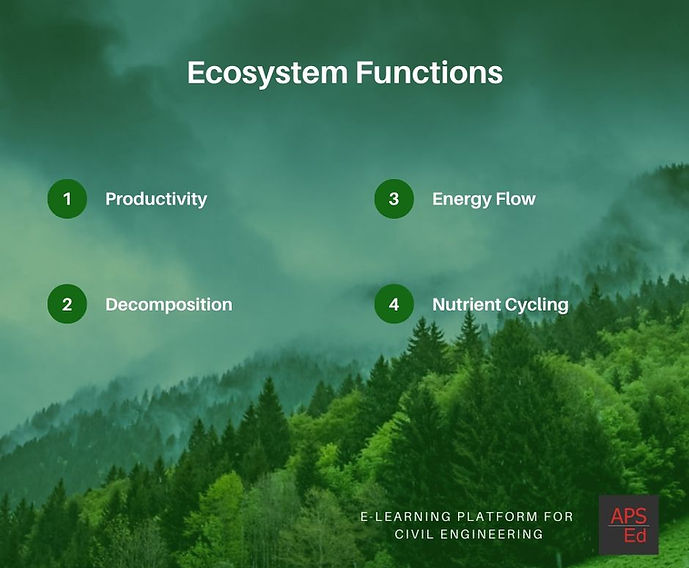Functions of an ecosystem | Environment
.jpg)
How does components of an ecosystem function as a single unit - Productivity, Decomposition, Energy flow and Nutrient cycling
Ecosystem functions
To understand how an ecosystem functions as a single unit we need to see the following aspects.
-
Productivity
-
Decomposition
-
Energy flow
-
Nutrient cycling
Productivity
Productivity starts with the basic energy source sun. The solar energy is used by plants which produce the organic matter or what we call as the biomass. So solar energy is used for photosynthesis and these plants produce biomass. Based on that we define productivity.
-
The rate of biomass production is calculated in – productivity kcal per year.
-
From solar energy, there are other sources also which will affect productivity i.e how much nutrients are available, how much water is available and type of soil.
Primary productivity - terms related to productivity are: Gross Primary Productivity (GPP) and Net Primary Productivity (NPP)
Gross Primary Productivity (GPP)
-
It is the rate of biomass produced during photosynthesis - the total production. And during the respiration of the plants, a certain amount of GPP is used up for respiration.
-
It is the remaining GPP the consumers get to consume.
Net Primary Productivity (NPP)
-
NPP = GPP – R (respiration)
-
It is the remaining GPP after substituting the used up GPP for respiration. The available biomass for consumption by heterotrophs or consumers.
Secondary productivity - It is the rate of production of organic matter by the consumers. How much new organic matter the consumers produced it is known as the secondary productivity.
Decomposition
During the production and consumption, there is a lot of organic matter left behind due to the dead plants and animal remains and their fecal matter. These make the raw material for decomposition. And as we mentioned earlier, without decomposition the ecosystem can’t survive.
Steps of decomposition
-
Fragmentation: the organic matter is broken into small parts by the detrivores.
-
Leaching: the process by which the broken down organic matter drain into sol.
-
Catabolism: it is the process by which the organic matter is converted into the simpler organic matter with the help of bacterial and fungal enzymes.
-
Humification and mineralization: these are the process that takes place during the decomposition in the soil.
Humification: In the process of humification a dark color substance is formed that we call humus. And this hummus is highly resistant to microbial action and thus the decomposition takes place at a very slow rate. This layer stays near the surface and acts as the reservoir of nutrients.
Mineralization: the humus formed during the humification is then further decomposed and during it, the nutrients are released (inorganic) and this process is known as mineralization.
This whole process of decomposition depends on the climate, whether it is a dry or wet climate and the types of decomposers available.
Energy Flow
Energy is very sufficient for the life to sustain on earth and this energy is transferred through organisms. The energy flows through different trophic levels of the food chain.
-
Energy flow is also known as calorific flow.
-
The producers acquire energy from the sun and produce food from that energy.
-
Then the primary consumers consume that food and acquire energy from the food produced by plants.
-
Then the secondary consumers consume these primary consumers and acquire energy from primary consumers.
-
Then as a final consumption, the decomposers decompose the consumers when they are dead and then the energy flows from the consumers to the decomposers.
Though all the energy acquired by the plants is not reaching the decomposers as a lot of energy is lost during the consumption.
Nutrient cycling
A nutrient cycle refers to the exchange and movement of organic matter and inorganic matter back in to the production of living matter. Nutrient cycling is regulated by the food web, as per the consumption of organisms. The decomposers decompose the organic matter into inorganic nutrients. This is known as nutrient cycling.
-
Nutrient cycles occur within the ecosystem itself.
-
The nutrient cycle is important in an ecosystem because all organisms depend on one another and are vital for the survival of the living organisms.
-
These organisms are linked by the flow of nutrients which is engineered by the nutrient cycle.
-
It is the nutrient cycle that regulates the flow of substances in an ecosystem.
APSEd ESE General Studies Package
Generally speaking from the last year patterns, questions are of two types.
1. General understanding of topics
For example, they ask questions like - Environmental Impact Assessment (EIA) is aimed to help ________.
If you have understood EIA, this question can be answered easily.
2. Specific questions/ terms
For example, they ask questions like - The ‘Minamata Tragedy’ was caused by the eating of fish growing in the Minamata Bay contaminated with _________.
This kind of questions needs extra reading after understanding the topics.
Our study package for ESE General Studies is designed as per this latest question pattern.
APSEd
APSEd is an E-learning platform for Civil Engineering by IIT-B Graduates. Get access to all in one place!
-
Video Lectures & Study Material
-
Practice Questions & Mock Tests
-
Exclusive Doubt Support
600+ learners are studying with us. Join them and learn with us for an optimized learning experience.





